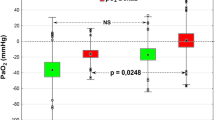Abstract
Objective
To study the validity and safety of the traditional apnea test in children, and to evaluate a mathematical equation estimating the hemodynamic response to the apnea test.
Design
A prospective clinical study.
Setting
Pediatric ICU
Patients and participants
38 pediatric patients suffering severe brain injury aged 2 months to 17 years, undergoing apnea testing for brain death.
Measurements and results
Apnea tests were performed 61 times (once in 19 patients, twice in 15, and 3 times in 4 patients). Mean PaCO2 was 41.1±10.6 mmHg before apnea and increased to 68.0±17.6 at 5 min. PaCO2 increased to 81.8±20.1 and 86.0±25.6 at 10 and 15 min, respectively. There was a mean PaCO2 increase by 5.38±1.4 mmHg/min in the first 5 min, and 2.75±0.5 mmHg/min during the next 5 min. We found a statistically significant (p<0.05) linear relationship between the natural logarithm of PaCO2, time, and the logarithm of the initial level of PaCO2. An inverse linear relationship (p<0.05) was found between systemic mean arterial pressure (MAP) and initial level of PaCO2 presented as mathematical correlations and nomograms.
Conclusions
By using our model for predicting MAP and PCO2 prior to apnea testing, hemodynamic embarrassment can be anticipated and prevented, thus allowing a safer procedure in the detection of brain death. Despite the fact that continuous cardiorespiratory monitoring is important, hemodynamic disturbances can be estimated before the apnea test, thus allowing a safer approach to brain death detection.
Similar content being viewed by others
References
Pallis C (1983) ABC of brain stem death. The position in the USA and elsewhere. BMJ 286:209–210
Schaffer JA, Coronna JJ (1978) Duration of apnea needed to confirm brain death. Neurology 28:661–666
Earnest MP, Beresford R, McIntyre GH (1986) Testing for apnea in suspected brain death. Methods used by 129 clinicians. Neurology 36:42–44
Ropper AH, Kennedy SK, Russell L (1981) Apnea, testing in the diagnosis of brain death: clinical and physiological observations. J Neurosurg 55:942–946
Pitts LH, Kakhs J, Caronna J, Jennet S, Hoff JT (1978) Brain death, apneic diffusion, oxygenation and organ transplantation. J Trauma 18:180–183
Winer BD (1971) Factorial experiments in which some of the interactions are confounded: examples with repeated measures. In: Winer BD (ed) Statistical principles in experimental design. McGraw Hill, New York, pp 635–639
Belsh JM, Blatt R, Schiffman LP (1986) Apnea testing in brain death. Arch Intern Med 146:2385–2388.
President's Commission for the Study of Ethical Problems in Medicine and Biomedical and Behavioral Research defining Death (1981) Washington, DC, Government Printing Office, pp 160
Rowland TW, Donnelly JH, Jackson AH (1984) Apnea documentation for determination of brain death in children. Pediatrics 74:505–508
Outwater KM, Rockoff MA (1984) Apnea testing to confirm brain death in children. Crit Care Med 12:357–358
Perel A, Berger M, Cotev S (1983) The use of continuous flow of oxygen and PEEP during apena in the diagnosis of brain death. Intensive Care Med 9:25–27
Marks SY, Zisfein Y (1990) Apneic oxygenation in apnea tests for brain death. A controlled trial. Arch Neurol 47:1066
Report of the Ad Hoc committee of the Harvard Medical School (1968) To examine the definition of brain death: A definition of irreversible coma. JAMA 201:337–340
Eger EI, Severinghaus JW (1961) The rate of rise of PaCO2 in the apneic anesthetized patient. Anesthesiology 22(3):419–425
Hanks EC, Ngai SH, FWK BR (1961) The respiratory threshold for carbon dioxide in anesthetized man. Anesthesiology 22:393–397
Kissoon N, Frewen TC, Bloch M, Gayle M, Stiller C (1989) Pediatric organ maintenance: pathophysiologic derangements and nursing requirements. Pediatrics 84:688–693
Bircher N, Safar P, Eshel G et al (1982) Cerebral and hemodynamic variables during cough induced CPR in dogs. Crit Care Med 10:104
Novitzky D, Cooper DCK, Morell D et al (1988) Change from aerobic to anaerobic metabolism after brain death, and reversal following triodothyronine therapy. Transplantation 45:32–36
Grose A, Novitzky D, Cooper DKC (1988) Myocardial and pulmonary histopathologic changes. Transplant Proc XX (sn(55) [Suppl7]:29–32
Riviello JJ, Sapin JI, Brown LW, Truex RC, Grover WD (1988) Hypoxemia and hemodynamic changes during the hypercarbia stimulation test. Pediatr Neurol 4:213–218
Benzel EC, Gross CD, Hadden TA, Kesterson L, Landreneau MD (1989) The apnea test for the determination of brain death. J Neurosurg 71:191–194
Frum J, Epstein RM, Cohen G (1959) Apneic oxygenation in man. Anesthesiology 20:789–798
Wetzel RC, Setzer N, Stiff JL, Rogers MC (1985) Hemodynamic responses in brain dead organ donor patients. Anesth Analg 64:125
Bloomfield E (1989) Extracerebral complications of head injury. Critical Care Clin 5:881–892
Novitzky O, Cooper PKC, Reichart B (1987) Hemodynamic and metabolic responses to therapy in brain dead potential organ donors. Transplantation 43:852–853
Miller JR, Nugent SK, Rogers MC (1979) Neurogenic pulmonary edema in childhood. Pediatrics 79:94–706
Author information
Authors and Affiliations
Rights and permissions
About this article
Cite this article
Paret, G., Barzilay, Z. Apnea testing in suspected brain dead children — physiological and mathematical modelling. Intensive Care Med 21, 247–252 (1995). https://doi.org/10.1007/BF01701482
Received:
Accepted:
Issue Date:
DOI: https://doi.org/10.1007/BF01701482




